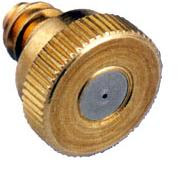The main problem I have always had with building a homemade aeroponics system is the clogging spray nozzles. I was in a hydroponics supply store the other day when it occurred to me the aeroponics system I was looking at did not use any spray heads. As I looked over the new hydroponic gardening system, I marveled at how simple the design really was. With the right pump and correct assembly, the following homemade aeroponics system is relatively problem free.
Look closely at the store bought aeroponics system here. There is a 20 gallon (75 liter) reservoir. There are several channels 4 or 6 inches in diameter and several feet long. Every 6 or 8 inches there is a hole drilled into the channel to accomodate a plant. The channels are pitched to allow drainage back to the reservoir.
There is a 1/2 inch line run down the center of each channel and capped at the end. All the lines are connected at the other end by a manifold and attached to a pump. At any point along the 1/2 line where spray is desired a 1/16 inch drill bit is used to cleanly make a small hole (usually one between each plant site).
homemade aeroponics system
Our homemade aeroponics system will be made much the same. 1/2 inch PVC is cut to length and capped at one end. Spray locations are marked and drilled into the 1/2 inch PVC. The line is held in place by drilling two small holes and fastening a zip tie every few feet.
Channels can be made of 4 inch or 6 inch PVC and will have to be sealed at one end with caps. The other end may be sealed or left open depending on how drainage back to the reservoir is handled. 2 1/2 or 3 inches holes are cut every 6 to 8 inches to accomodate netted pots (or other planting container).
At one end of the homemade aeroponics system, the 1/2 inch lines elbow out of their channels and are joined together by a series of "T" fittings. This is known as a manifold. One end of the manifold is left open to connect to the pump. Your pump may be external, as in the system up top, or you may use a submersible pump. Either way, your pump needs to be able to deliver a water pressure of 45 to 60 psi.
Finally, any large, cheap plastic tote may be used for the nutrient reservoir. A homemade aeroponics system like the size above would require a 20 gallon (75 liter) reservoir. It is always best to choose a dark tote, to keep as much light from the nutrient reservoir as possible. This will prevent algae growth and therefore help prevent fungus gnats.
A Few Final Notes
When constructing any homemade hydroponics system you should always use PVC, and not CPVC. CPVC is known to slowly leach harmful chemicals. To prevent leaks, be sure to use PVC cleaner on all parts BEFORE you apply PVC glue and join the parts.
source http://www.jasons-indoor-guide-to-organic-and-hydroponics-gardening.com/homemade-aeroponics-system.html




